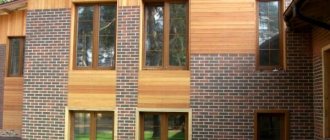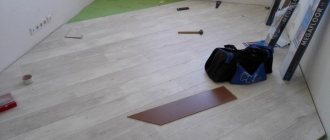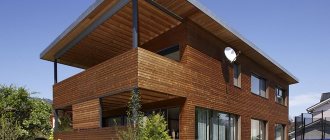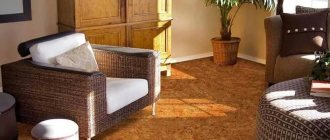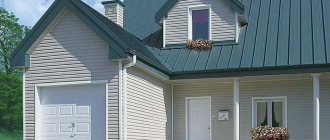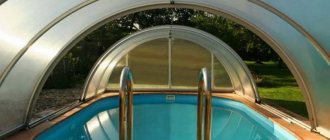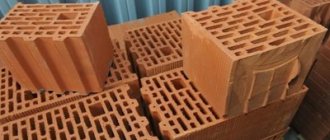Any owner always strives to ensure that his home is both comfortable to live in and attractive in appearance. And both of these factors directly depend on the quality of the roof, so special attention is always devoted to the selection of roofing covering. It is necessary to try to settle on an option that would combine high reliability, an elegant appearance (preferably “with a twist” that makes it stand out against a monotonous background), durability of the roof, guaranteed by the manufacturer and proven by the practice of using the material, and, finally, a relatively affordable price .
Composite tiles pros and cons
The task, as you can see, is not an easy one, but with the modern range of roofing coverings, it is still solvable. So, among the relative new products on the Russian building materials market, we recommend taking a closer look at composite tiles.
The combination of a “classic” appearance with the versatility and durability of modern construction materials, coupled with a convenient installation system (much simpler than that of piece tiles), is gradually bringing this type of roofing to the “top” of popularity. Interestingly, some potential homeowners do not even know exactly about the availability of such materials, or have insufficient information about them. First of all, this publication is dedicated to this category of users - composite tiles pros and cons, a review of the most popular brands and tips on selection.
What it is?
The base is a sheet of steel, which is protected on both sides by an aluminum-zinc alloy. The outer side of the material is covered with natural stone granules of different colors. The stone chips are covered with a special glaze on top. The roof does not have a characteristic shine; the metal is well hidden from the eye of the observer. A metal sheet coated with granulate reliably insulates the roof from rain and wind.
Tile surface granules
Modern roofing made of composite tiles is a multi-layer complex structure. It includes components such as a vapor barrier film, wind protection, a layer of insulation, roofing, etc. In addition, the structure of the roof provides ventilation of the space underneath and reliable protection against heat loss. A set of measures is being taken to prevent the formation of condensation. If you want to purchase high-quality composite tiles at manufacturer’s prices, then https://www.icopal-russia.ru/kompozitnaia-cherepitsa-decra/ can help you with this.
Structure of composite tiles
Roofing and collection configurator
On the manufacturer's website we found a convenient option - a configurator that will help you choose a collection and color, as well as find out about promotional offers. The materials are combined according to design features into the following collections:
- CLASSIC (Classic) . The sheets follow the classic shape of medieval tiled roofs. Housing under such a roof takes on the expressive appearance of a house “with history.”
- DIAMANT (Diamond) . Roof covering with classic ceramic profile. The sheet surface is 10% larger, saving 10% of your budget.
- HERITAGE (Heritage) . The elegant design recreates the wavy profile characteristic of terracotta tiles.
Material from the CLASSIC collection Source gerardroofs.eu
- MILANO (Milano) . The material with a classic Roman profile gives the building a majestic appearance. The design remains relevant and is especially suitable for structures with steep slopes.
- SHAKE (Shake) . The stylish design of traditional wooden shingles will suit both classic and modern projects. A house under such a roof will always look respectable.
- SHINGLE (Shingle) . The coating recreates the texture of a handmade cedar wood roof. The fashion for wooden roofs never completely went away, but now it is experiencing a resurgence.
- SLATE (Slate) . The roof covering with the unusual texture of natural alpine slate looks authentic and emphasizes the durability and mechanical strength of the material.
The roof will help emphasize the authentic look of the house Source gerardroofs.eu
Characteristics of composite tiles
The colors can be monochromatic, variegated, with stains or textures. Often sheets of composite tiles imitate some natural material.
- The length of the sheet is regulated by the standard - it is 140 cm, and the width varies.
- According to GOST standards, fluctuations in the thickness of the steel sheet should not exceed 0.1 mm.
- Stone granules + protective acrylic glaze provide additional strength.
- Durability depends on the thickness of the aluminum-zinc layer. This option varies depending on the brand. For example, if the volume of aluminum-zinc coating reaches 190 g per 1 m2, then the manufacturer guarantees a service life of 50 years.
- Metal and stone chips are completely fireproof. The acrylic polymer coating contains silicon, which allows it to withstand temperatures up to 135 C. In practice, this acrylic coating can withstand open fire for 6 hours.
- The materials are selected so that when heated by sunlight they do not emit any toxic fumes.
- Metal has a high coefficient of thermal conductivity, so when installing the roof it is necessary to insulate it.
- It bends well, so it is very convenient for designer roofs with a large number of bends.
Table of characteristics of Dekra composite tiles
| Characteristic | Classic | Stratos | Novel |
| Sheet size, mm | 1324x410 | 1300x360 | 1100x375 |
| Usable area, sq. m | 0,465 | 0,390 | 0,368 |
| Number of sheets per sq. m | 2,15 | 2,54 | 2,72 |
| Steel thickness, mm | 0,43 | 0,43 | 0,45 |
| Weight of one sheet, kg | 3,10 | 2,80 | 2,70 |
| Weight of one sq. m, kg | 6,70 | 7,20 | 7,46 |
| Permissible roof slope, degrees | from 12 to 90 | from 15 to 90 | from 15 to 90 |
Color solutions
Plastic tiles are a unique and popular roofing material that comes in a huge range of colors. The dyes used in the production process allow you to obtain a wide range of colors. Modern tile manufacturers compile catalogs of color schemes for their products, which allows you to most accurately and successfully select the required color of the roofing covering, and construction computer programs will help you see the final result of the planned work.
The unique properties and characteristics of the artificial material make it possible to maintain bright shades throughout the entire period of operation , which is an undeniable advantage in the aesthetic design of premises.
Production Features
The steel sheet serves as the basis of the product. It is coated on both sides with a layer of aluminum-zinc (an alloy of zinc and aluminum). This is necessary to protect against corrosion and minor scratches that the granulate can cause.
Next, on top of the aluminum-zinc, a protective layer is applied against heating by the sun's rays - the SPT composition. Its second function is protection against the rooting of mosses, lichens and the formation of colonies of microorganisms. Finally, the SPT coating provides UV protection.
Then a decorative layer of stone granules is applied. The chips are made from natural stone of the desired shade. The stone chips are strengthened in a layer of acrylate, selected in composition so that it does not evaporate when heated by the sun. If necessary, the stone chips are tinted to achieve the desired color of the roof.
Tile production
The introduction of dye into natural stone and its protection with a layer of acrylate ensures complete resistance to ultraviolet radiation, moisture and temperature changes. Thanks to this, the surface is able to maintain its original appearance for decades.
The final stage of manufacturing is the application of pure acrylate without styrene. The layer turns out completely transparent. The coating protects the stone chips from falling off under the influence of rain and wind.
Tips for choosing
When purchasing plastic tiles made from PVC material, professional builders advise paying attention to the following points:
- uniformity and uniformity of color;
- surface smoothness;
- absence of defects, cracks and chips on the coating elements;
- exceeding the permissible weight.
Only the purchase of high-quality products from well-known manufacturers guarantees high quality and reliability of the design while maintaining all technological properties.
Layer structure
To understand how the material is structured, as well as what function each layer performs, you need to look at the structure in more detail. As an example, the Dekra brand is considered.
- The base is a steel sheet about 0.43 mm thick.
- The metal is protected from corrosion on both sides by an aluminum-zinc coating up to 275 g/m2. It is applied by hot galvanization.
- A special primer is applied over aluminum-zinc. Its purpose is to ensure adhesion with subsequent layers. Also, acrylic primer allows the metal to withstand sudden temperature changes without deforming.
- Next, the surface is covered with basalt chips. It performs a decorative function. A layer of stone chips protects the steel base from mechanical stress and solar radiation. In addition, stone chips improve sound insulation.
- The final stage is to protect the stone chips with transparent acrylic glaze. This measure prevents shedding under the influence of wind and rain.
Let's sum it up
A plastic roof is practical, holds a distributed load well, is not subject to corrosion and can be 90% transparent. At the same time, most plastic panels for roofs do not have very high resistance to point loads and a short service life, although there are materials that stand out in terms of these characteristics compared to other polymers.
Here's what the roof plastic is called:
- Polycarbonate. This is a whole family of materials, which includes:
- especially durable, even bulletproof, monolithic polycarbonate;
- lightweight and cheap cellular phone that effectively prevents heat loss;
- thin, but profiled to hold up to 350 kg/m2 load.
- Profiled PVC . Less durable than profiled polycarbonate, but with biaxial orientation it is more elastic and better able to withstand impact loads.
- Composite plastic . Specialized multicomponent materials, difficult to produce and therefore expensive. They are used for constructing roofs in aggressive conditions and for vandal-proof structures.
The roofs of gazebos, verandas, greenhouses, winter gardens, greenhouses, galleries, and canopies are usually made of plastic. Monolithic polycarbonate is used for glazing the atriums of commercial and public buildings, and sometimes for partially covering the roofs of private houses.
pros
- Visually no different from natural tiles.
- Relatively light weight compared to natural tiles. This allows it to be used even on light structures without reinforcing the load-bearing elements.
- The roof surface has a much higher noise absorption coefficient than conventional metal tiles.
- The stone chips are recessed in the acrylic mass, so they do not crumble from rain and wind.
- Compact dimensions make installation easy.
- The metal under multi-layer protection is not damaged by corrosion.
- Does not accumulate static charge.
- All components are non-flammable, only if exposed to open fire for more than 6 hours, the acrylic may melt slightly.
- There is no deformation of the canvas during sudden temperature changes.
- The roof is very well protected from destruction by ultraviolet rays.
- The color saturation remains for decades - the dye does not fade.
- It is cheaper on the market than clay, but looks just as good.
- The surface is immune to the destructive effects of acids and alkalis.
- Flexibility allows you to accurately finish even roofs with complex geometric configurations.
- The mount is designed so that water cannot enter there. Self-tapping screws + special locks securely fasten the sheet to the base.
- The manufacturer provides a 50-year warranty.
Installation
Polymer sand tiles have protrusions on the sides, with the help of which they are secured to the frame. Side locks secure the individual roof elements together. For additional fixations, there are additional holes on the tiles.
Installation work on laying tiles begins from the bottom of the slope. The fastening of the tiles to the sheathing should not be rigid, which will help to further prevent deformation of the elements.
Installation is quite easy and can be done even by a non-professional. The main thing is to follow the steps of work:
Roofing work on sheathing at intervals of thirty-five centimeters;- Next comes the installation of lower tides;
- Then the rows are laid out from bottom to top;
- Side and ridge elements are installed.
Experts also recommend paying attention to:
- for uniformity and uniformity of color. In the photographs presented, which depict the work performed by the company, you can notice either a uniform color (and this indicates good quality), or changes in shade from tile to tile, which indicates low quality dyes or polymers;
- on the surface texture - it should be smooth;
- for the correct geometric shape and smooth edges of the tiles;
- by weight Too much weight indicated for this type of coating indicates an insufficient amount of the polymer component. Normally, the weight should not exceed 22 kg/sq. m.
In addition, aesthetically attractive tiles are superior in many respects when compared with natural ones; at the same time, they are much heavier than metal tiles and more expensive than sheet roofing materials.
Popular brands
Metrotile: natural basalt topping
Let's start with the most popular, expensive and first brand of composite tiles for the Russian market - Metrotile. These Belgian tiles are made from particularly flexible Luxembourg steel, making them suitable for roofs with almost any surface.
Here is the composition of Metrotile roofing sheet:
- On top is a transparent acrylic glaze, which helps clean the roof from dust during rain.
- Next comes granulate of natural stone - basalt.
- The next layer is acrylic, which fixes the natural sprinkles.
- The sheet is based on aluzinc, 190 UAH/m2, with a metal thickness of 0.45.
- The penultimate one is an acrylic primer, as an additional anti-corrosion protection for the metal sheet.
- And in the very heart is aluminum zinc, steel 9 mm thick. It is produced for Metrotile by Luxembourg, a special brand that is known for its excellent flexibility and stretchability.
Roser
South Korean tiles from Roser are a complete mystery to other manufacturers, because their manufacturing technologies are strictly confidential and patented. But buyers especially like the fasteners from Roser - without through holes.
Gerard
Another good tile is produced by Gerard, the New Zealand company Ahi Roofing, but the production itself is located in America and Europe. As a basalt topping, Gerard uses crushed stone, which is mined in New Zealand quarries, with a natural color. Over time, this color plays with new shades, quite picturesquely.
For products that will be sold in Europe, Gerard built a plant in Hungary, but both chips and profiled sheets are still imported from New Zealand. Sheet coating – aluzinc, 150 g/m2, thickness 0.45.
Kami Terra Plegel: Swedish quality
The basis of such tiles is steel with a thickness of 0.5 to 0.9 mm, which is coated on both sides with a layer of zinc of 275 g/m2. Thanks to such a generous zinc coating, such a roof is resistant to temperature changes from -40°C to +120°C, can withstand physical loads of up to 300 kg and wind loads of up to 250 km/h. But here lies an unpleasant point: it is this manufacturer that produces composite tiles without aluminum zinc.
Plastic roofing materials: an overview of the three main types
The roof can be made from about a dozen types of plastic, but three are most often used:
- polycarbonate;
- polyvinyl chloride (PVC);
- composite plastic.
The previously popular acrylic, also known as plexiglass, is now almost never used, since its properties are much inferior to modern plastic roofing materials.
Polycarbonate
Among roofing plastics, polycarbonate has no competitors in terms of strength. All other things being equal, the resistance of polycarbonate sheets to impact, point and distributed loads is tens and even hundreds of times greater than that of other materials.
This made it possible to create a whole family of roofing plastic materials with different properties based on polycarbonate:
- monolithic polycarbonate;
- profiled polycarbonate;
- cellular polycarbonate.
All these types of polycarbonate are actively used as roofing material. Moreover, in total they occupy 80-90% of this market.
Monolithic polycarbonate: when hail and bullets don’t matter
Monolithic or solid polycarbonate is the very exception to the rule about the low resistance of roofing plastics to point loads. This is a very durable material. So strong that some standard tests simply don't work for it. For example, a Charpy strength test without a cut does not give any results because the material simply cannot be destroyed. With a thickness of 10 mm or more, monolithic polycarbonate can withstand small-caliber bullets, which is why it is used to create multilayer bulletproof glass.
Due to its impressive strength, monolithic polycarbonate is used as a plastic roofing material in the construction of critical facilities. In particular, it is used for glazing arched and domed roofs of atriums of shopping centers, markets, train stations, airports, museums, metro entrances and other public and commercial buildings. Because of its strength, monolithic polycarbonate is the only material from which plastic sheets are made for the roofs of private houses and enclosed verandas.
Flaws
Despite the composition and manufacturability of the product, composite roofing material has its drawbacks. Just like its advantages, they are associated primarily with the characteristics of its components. According to reviews from experienced roofers, the disadvantages of composite tiles are as follows:
- High price . Due to the excellent performance qualities, and they are actually beyond praise for composite tiles, the price of this material is quite high - it starts from 700 rubles per square meter. However, to start work you will need more fittings and additional materials, which increase costs by 1.5-2 times.
- Fading and shedding of the top layer . Due to the advantages of the material, it is resistant to fading. However, due to carelessness, you can find products that, when exposed to sunlight, will lose color or crumble. To preserve such material, it should not be exposed to sunlight, which is practically impossible when using a roof.
- Moss . Composite tiles, like traditional clay tiles, are a favorable environment for the germination of moss spores or plant seeds. Therefore, it is necessary that there is no dense foliage above the roof that creates shadow and dampness.
Remember! Tiles made of high-quality composite are a very convenient and beautiful material for covering the roof of any complexity of a private house. The main thing is not to run into manufacturers who frankly don’t care about the quality of their products. To find a durable coating, you need to open any forum and read honest reviews from craftsmen and homeowners.

